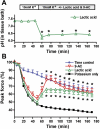Lactic acid restores skeletal muscle force in an in vitro fatigue model: are voltage-gated chloride channels involved?
- PMID: 22237405
- PMCID: PMC3330741
- DOI: 10.1152/ajpcell.00279.2011
Lactic acid restores skeletal muscle force in an in vitro fatigue model: are voltage-gated chloride channels involved?
Abstract
High interstitial K(+) concentration ([K(+)]) has been reported to impede normal propagation of electrical impulses along the muscle cell membrane (sarcolemma) and then also into the transverse tubule system; this is one considered underlying mechanism associated with the development of muscle fatigue. Interestingly, the extracellular buildup of lactic acid, once considered an additional cause for muscle fatigue, was recently shown to have force-restoring effects in such conditions. Specifically, it was proposed that elevated lactic acid (and intracellular acidosis) may lead to inhibition of voltage-gated chloride channels, thereby reestablishing better excitability of the muscle cell sarcolemma. In the present study, using an in vitro muscle contractile experimental setup to study functionally viable rectus abdominis muscle preparations obtained from normal swine, we examined the effects of 20 mM lactic acid and 512 μM 9-anthracenecarboxylic acid (9-AC; a voltage-gated chloride channel blocker) on the force recovery of K(+)-depressed (10 mM K(+)) twitch forces. We observed a similar muscle contractile restoration after both treatments. Interestingly, at elevated [K(+)], myotonia (i.e., hyperexcitability or afterdepolarizations), usually present in skeletal muscle with inherent or induced chloride channel dysfunctions, was not observed in the presence of either lactic acid or 9-AC. In part, these data confirm previous studies showing a force-restoring effect of lactic acid in high-[K(+)] conditions. In addition, we observed similar restorative effects of lactic acid and 9-AC, implicating a beneficial mechanism via voltage-gated chloride channel modulation.
Figures







Similar articles
-
Additive protective effects of the addition of lactic acid and adrenaline on excitability and force in isolated rat skeletal muscle depressed by elevated extracellular K+.J Physiol. 2007 Jun 1;581(Pt 2):829-39. doi: 10.1113/jphysiol.2007.129049. Epub 2007 Mar 8. J Physiol. 2007. PMID: 17347268 Free PMC article.
-
Effect of transverse-tubular chloride conductance on excitability in skinned skeletal muscle fibres of rat and toad.J Physiol. 1998 Jun 1;509 ( Pt 2)(Pt 2):551-64. doi: 10.1111/j.1469-7793.1998.551bn.x. J Physiol. 1998. PMID: 9575303 Free PMC article.
-
Potassium-induced potentiation of subtetanic force in rat skeletal muscles: influences of β2-activation, lactic acid, and temperature.Am J Physiol Cell Physiol. 2021 Nov 1;321(5):C884-C896. doi: 10.1152/ajpcell.00120.2021. Epub 2021 Oct 6. Am J Physiol Cell Physiol. 2021. PMID: 34613841
-
Lactic acid and exercise performance : culprit or friend?Sports Med. 2006;36(4):279-91. doi: 10.2165/00007256-200636040-00001. Sports Med. 2006. PMID: 16573355 Review.
-
Modulation of force development by Na+, K+, Na+ K+ pump and KATP channel during muscular activity.Can J Appl Physiol. 2002 Jun;27(3):296-315. doi: 10.1139/h02-017. Can J Appl Physiol. 2002. PMID: 12180319 Review.
Cited by
-
Blood lactate concentration after exposure to conducted energy weapons (including TASER® devices): is it clinically relevant?Forensic Sci Med Pathol. 2013 Sep;9(3):386-94. doi: 10.1007/s12024-013-9436-4. Epub 2013 Apr 19. Forensic Sci Med Pathol. 2013. PMID: 23605975 Review.
-
Comment on: The Effect of Pedal Pump Lymphatic Technique Versus Passive Recovery Following Maximal Exercise: A Randomized Cross-Over Trial.Sports Med Open. 2022 Apr 11;8(1):51. doi: 10.1186/s40798-022-00443-w. Sports Med Open. 2022. PMID: 35404022 Free PMC article. No abstract available.
-
Pathogenesis of Musculotendinous and Fascial Injuries After Physical Exercise - Short Review.Int J Gen Med. 2023 Nov 13;16:5247-5254. doi: 10.2147/IJGM.S432749. eCollection 2023. Int J Gen Med. 2023. PMID: 38021047 Free PMC article. Review.
-
Signaling pathways regulated by natural active ingredients in the fight against exercise fatigue-a review.Front Pharmacol. 2023 Dec 14;14:1269878. doi: 10.3389/fphar.2023.1269878. eCollection 2023. Front Pharmacol. 2023. PMID: 38155906 Free PMC article. Review.
-
Lactic acidosis: implications for human exercise performance.Eur J Appl Physiol. 2025 Jul;125(7):1761-1795. doi: 10.1007/s00421-025-05750-0. Epub 2025 Mar 15. Eur J Appl Physiol. 2025. PMID: 40088272 Free PMC article. Review.
References
-
- Allen DG, Lamb GD, Westerblad H. Skeletal muscle fatigue: cellular mechanisms. Physiol Rev 88: 287–332, 2008 - PubMed
-
- Allen DG, Lannergren J, Westerblad H. Muscle cell function during prolonged activity: cellular mechanisms of fatigue. Exp Physiol 80: 497–527, 1995 - PubMed
-
- Bandschapp O, Ginz HF, Soule CL, Girard T, Urwyler A, Iaizzo PA. In vitro effects of propofol and volatile agents on pharmacologically induced chloride channel myotonia. Anesthesiology 111: 584–590, 2009 - PubMed
-
- Bruton JD, Lannergren J, Westerblad H. Effects of CO2-induced acidification on the fatigue resistance of single mouse muscle fibers at 28°C. J Appl Physiol 85: 478–483, 1998 - PubMed
Publication types
MeSH terms
Substances
Grants and funding
LinkOut - more resources
Full Text Sources

